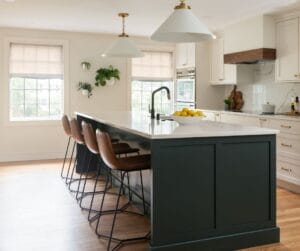19 Apr Build an Addition or Renovate Your Existing Home?
When you’re able to compare design options and relative costs, the decision is much easier – and can save a lot in the long term.
It happens. The home that once worked perfectly for you now feels like wearing a shoe two sizes too small. You don’t want to move. You just need more – more storage, more space, and a more functional floor plan. It’s an all-too-common problem.

Reimagined and remodeled kitchen
Many homeowners already using every square inch of their existing home see the solution as building an addition that would provide more available space, especially if they have a long wish list of improvements. But remodeling can also be a viable alternative. How do you know which way to go?
When considering an addition, there are some key factors you’ll want to look at:
What type of addition? Additions can range from a single room to multi-room structures that are integrated into the existing home. If your home is a single story, another option may be to build up by adding a second level.
How will the addition integrate into your existing home? Additions don’t stand alone, they are part of your home, so some remodeling and redesign of the existing structure will be required to seamlessly integrate the new space.
What are the local zoning ordinances and regulations regarding home additions? You’ll need to understand and consider what your municipality requires in terms of proximity to lot lines and size. Even the height of your home may be restricted. Certain lots, such as those near wetlands, may have special restrictions.
What will the cost be? Additions, in general, are more costly than renovating existing space but they also add square footage and value to the home. They bring most of the requirements and considerations of building a new home. These may include excavation, foundation work, roofing, siding, and upgrading electrical, plumbing as well as heating and cooling systems. And the costs of an addition go beyond the construction project itself. Examples are higher utility costs and higher property taxes.
But before you decide if an addition is the way to go, taking a step back and looking at your needs through the lens of remodeling your existing space and comparing this to an addition can help you determine options on how you can best meet your wishlist and get the most value. Asking the following questions will help:
Is there existing unused space, such as an attic or basement that could potentially be used? While not every basement or attic would be ideal for converting to usable living space, exploring that possibility will help determine whether that existing space may help meet your expansion needs.
Will reconfiguring your current floor plan open up the room you need? Many floorplans, especially those in older homes, can be reimagined in bold new ways. There may be rooms that are underutilized, walls that can be removed, or even a kitchen or bathroom that could be moved to optimize available space.
What are the costs of remodeling vs. adding on to the home? If remodeling looks like a viable alternative, costing out the two options can help you make an informed decision.

Reimagined entryway coatroom
One of our recent clients, a family in Winchester, MA, was initially considering a home addition. They loved their home, a traditional colonial, for the potential it had, but assumed to meet all their needs they would have to add additional square footage.
Because we are an integrated design-build firm, we are able to provide design and cost options to consider early on in the process. What many homeowners don’t realize is what can be accomplished within their existing space. It’s difficult to see beyond the limitations of existing walls and rooms, especially those you live with every day.
Our two main considerations were to design an effective solution and to keep an eye on overall costs for our client. Our architect started with their wish list and mapped out two scenarios.
The first was working within the home’s existing footprint. Using a “dollhouse” top-down view that lifts the roof to look at the entire first-floor layout allowed the architect and our design team to envision a radically different configuration that opened up the main living space and created the open sightlines the client desired.
Our team also mapped out the creation of an addition as a second option including a cost comparison to compare the two designs. This gave the family all the information they needed to make an informed decision. In this case, our family could clearly see that remodeling the existing home would not only give them what they wanted, it would save them significant time and expense.
How did it come out? Check out our portfolio to see the beautiful results and learn more about the details of this renovation project.
If you are weighing the pros and cons of adding on to your home or renovating your existing space, consider consulting with a creative and knowledgeable design build firm like Lee Kimball that manages your project from initial design to final completion. By having options and knowing what’s involved upfront, you’ll have the information you need to make the right decision for your home and family.

